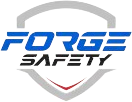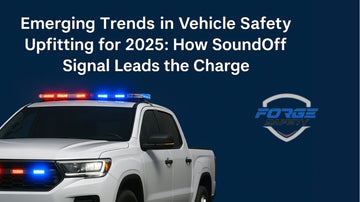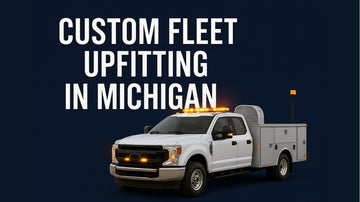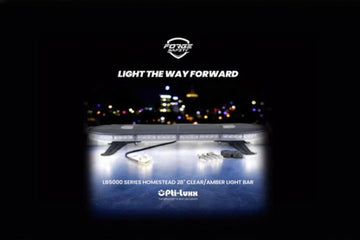Beacon lights are a vital safety tool for vehicles operating in high-risk or low-visibility environments. They are designed to enhance visibility signal warnings and ensure safety for both operators and the public.
This forge safety guide will explore the importance of beacon lights and why they are considered an essential tool for vehicles.
What are Beacon Lights?
Beacon lights are safety lights used on vehicles and equipment to help improve visibility and avoid accidents. They are especially important in areas where workers, vehicles, or machinery are moving in low-light or high-risk situations.
Beacon lights can be seen from a distance, making it easier for other drivers and people to spot the vehicle or machinery, lessening the chance of accidents.
These lights are often used in industries like construction, emergency services, agriculture, and transportation. They are typically bright, flashing, or rotating to catch attention.

-
Bright lights can be seen from long distances, even in poor weather.
-
Built to resist harsh conditions, including extreme temperatures and vibrations.
-
Many models use LED technology for lower power consumption.
-
Flashing, rotating, or steady lights for different situations.
-
Compact and adaptable to various vehicle types.
Why They aer Essential? The Core Purpose of Beacon Lights
People use beacon lights mainly to enhance safety by making things more visible and warning others about possible dangers. These lights help prevent accidents and keep operations running smoothly in different settings. [1]
1. Enhanced Visibility
Beacon lights are highly visible, even in low-light or dangerous weather conditions, making vehicles or work zone workers prominent to others.
2. Accident Prevention
By signaling warning or danger, they lessen the risk of collisions, especially in busy or high-risk areas like construction zones or highways.
3. Clear Communication
Beacon lights quickly convey important messages, such as an active work zone, a slow-moving vehicle, or an emergency situation.
4. Keeping with Regulations
Many industries, such as construction, mining, and logistics, mandate the use of beacon lights to meet safety and legal requirements.
5. Versatility Across Industries
From emergency services to agriculture, beacon lights are used to keep operations safe and efficient in various fields.
Industries That Rely on Beacon Lights for Safety
Beacon lights are important in many industries to keep people safe, help them see better, and avoid accidents. [2]

1. Construction and Roadwork
In construction and road work areas, amber flashing lights are used to show where work is happening and warn drivers to slow down, especially at night or during bad weather.
2. Emergency Services
Emergency autos, like police cars and ambulances, use flashing red or orange lights to help them get through traffic quickly and safely. These lights inform people to move out of the way during an emergency.
3. Utility Vehicles
Utility vehicles, like those used for maintenance, use amber or flashing lights to let people know they’re working. This helps workers stay safe from traffic and makes their work easier.
4. Transportation and Logistics
For transportation, oversized trucks and delivery vehicles use flashing lights to stay visible and warn others to be careful. Airport vehicles also use these lights to move safely around busy areas.
5. Agriculture and Mining
In farming and mining, flashing or rotating lights are used on large machines to let people nearby know the machines are working, especially in large, open spaces or low-light areas.
6. Manufacturing and Warehousing
In factories and warehouses, machines like forklifts and cranes use flashing lights to show when they’re operating, helping to prevent accidents.
How to Choose the Right Beacon Light?
With various options available, it’s important to consider factors that match your specific needs and operating conditions. [3]
-
Identify the key purpose of the beacon light. For example, construction sites may require bright and durable lights, while emergency vehicles may need high-intensity lights with multiple flashing patterns.
-
Evaluate where the beacon light will be used. For outdoor applications, choose weather-resistant models that can withstand extreme temperatures, rain, and dust.
-
Select a light with the appropriate brightness and visibility range. LED beacon lights are often preferred for their energy efficiency and powerful illumination.
-
Decide between battery-operated, hardwired, or magnetic-mount lights based on your vehicle’s setup and usage requirements.
-
Opt for lights with adjustable flashing modes to suit different situations, such as steady, rotating, or strobe patterns.
-
Look for strong materials and long-lasting designs to ensure reliability in harsh environments.
Installation and Maintenance Tips
The right installation and maintenance of beacon lights are important, hence here are a few tips;

Installation Tips for Beacon Light;
-
Install the beacon light at a high point on the vehicle or equipment for maximum visibility.
-
Secure the light using appropriate mounts or brackets to prevent vibrations from loosening it.
-
Follow the manufacturer’s wiring instructions carefully, ensuring connections are secure and insulated to avoid short circuits.
-
Make sure the power source (battery or vehicle power) is compatible with the beacon light’s requirements.
Maintenance Tips for Beacon Light;
-
Keep the light lens clean and free of dirt, debris, and moisture to maintain brightness.
-
Periodically inspect the light for any cracks, loose components, or signs of wear.
-
Regularly test the light’s flashing and brightness to ensure it’s working properly.
-
If the light dims or stops working, replace defective bulbs or LEDs immediately.
Final Words
Beacon lights help with visibility, prevent accidents, and meet safety rules. By selecting the right beacon light for the job, environment, and durability and ensuring proper setup and care, you can improve safety and efficiency. Whether in construction, emergency services, or any other industry, beacon lights are important for protecting workers, drivers, and the public.
FAQs
What are beacon lights used for?
Beacon lights are used to enhance visibility and signal warnings in low-light or hazardous conditions.
Can beacon lights be installed on any vehicle?
Yes, beacon lights can be installed on various vehicles, including utility, emergency, and construction vehicles.
How long do beacon lights last?
LED beacon lights can last up to 50,000 hours with proper maintenance.
Are beacon lights weather-resistant?
Yes, most beacon lights are designed to withstand harsh weather conditions like rain and extreme temperatures.
How do I maintain beacon lights?
Regularly clean the lens, check for damage, and replace faulty bulbs or LEDs to ensure optimal performance.
References
[1] https://highways.today/2022/09/21/beacon-lights/
[2] https://www.verifiedmarketreports.com/product/beacon-lights-market/
[3] https://www.vignal-group.com/en/p-which-beacon-to-choose.html









